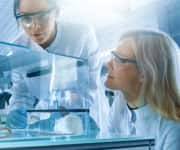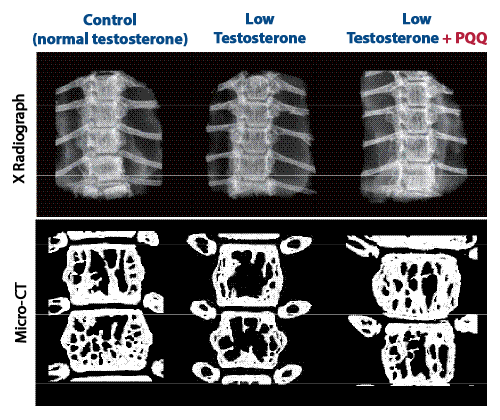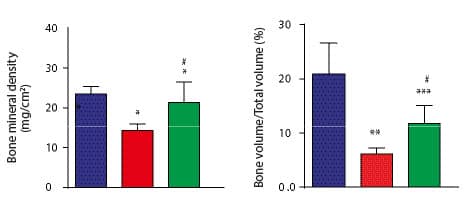Life Extension Magazine®
Many people think of osteoporosis as a disease that primarily affects elderly women. In reality, this condition is a substantial threat to some 2 million aging men as well.1,2
The decline in testosterone that occurs with age is believed to be an important cause of frail bones and increased fracture risk in men.2-5
A new study has emerged, indicating that testosterone deficiency may induce osteoporosis in men by causing oxidative stress.6
More importantly, this animal-model study revealed that supplementing with the nutrient pyrroloquinoline quinone (PQQ) protected bone strength by preventing the decline in bone-cell function.6
As a result, PQQ significantly slowed testosterone deficiency-related osteoporosis.
PQQ is best known for its ability to promote the generation of new mitochondria in the heart, brain, and other tissues.
This new study indicates that PQQ supplementation may soon emerge as a bone restoration strategy for men.
Dangers of Male Bone Loss

Osteoporosis is the gradual loss of bone mass and strength. Over time, it produces progressively fragile and weaker bones, raising the risk for fractures that can be disabling and costly—and can also lead to premature death.6-8
Long thought of as a disease exclusive to postmenopausal women, osteoporosis is now recognized as a substantial threat to millions of aging men as well.2,9 Studies show that men lose up to 1% of bone per year beginning at age 50 as testosterone levels significantly drop.6,10,11
This represents a major health concern because men are more likely than women to become disabled or to die after suffering an osteoporotic fracture.2,6
Researchers aware of the role played by oxidative stress in the development of osteoporosis in men12-14 set out to determine if a natural compound called PQQ could slow or reverse the impact of oxidative stress on bone tissue in mice with low testosterone levels.6 The results were remarkable.
What You Need to Know
How Bones Keep Integrity in Youth – And why They Lose it With Aging
- Our bones naturally maintain their integrity, shape, and strength over a lifetime by constantly remodeling themselves.26
- Bones accomplish this complex structural maintenance by two opposing but complementary mechanisms.26
- Bone builds up in areas where more strength is needed through the actions of cells called osteoblasts, which produce the proteins and deposit the minerals needed to form solid bone structures.
- Bone is removed from areas where it is less needed through the actions of cells called osteoclasts, which break down the bone matrix and resorb the minerals.
- But with aging, loss of sex hormones (estrogen and testosterone), and oxidative stress, the activity of bone-forming osteoblasts diminishes, while bone resorption by osteoclasts continues at the same rate, or even increases.27
- The net result of this imbalance is an overall loss of bone-mineral density, strength and integrity—which sets up older adults for potentially disabling fractures even after only relatively minor trauma.
- Most anti-osteoporosis drugs act mainly by stopping osteoclast activity, with little impact on bone-forming osteoblasts. As we see in this article, PQQ promotes osteoblast formation of new bone, while reducing osteoclast-induced bone loss.
What the Study Showed

The researchers used male mice that had been castrated.6 Removing the testes results in low testosterone levels similar to those seen in aging men, creating a model of “male menopause.”15,16
Next, the low-testosterone mice were divided into two groups: one that received supplemental PQQ and one that did not. A control group was not castrated and wasn’t given PQQ.
After 48 weeks, the researchers compared outcomes such as bone mineral density, bone volume, deposits of connective protein collagen, and numbers of bone-forming osteoblast cells.6
As expected, the untreated low-testosterone mice had significant reductions in all measures of bone integrity (such as mineral density and bone volume), increased activity of bone-resorbing osteoclast cells (which break down bone), and higher markers of bone loss and DNA damage.
By contrast, the low-testosterone mice that received the PQQ had significantly less bone loss, higher numbers of osteoblasts (cells that form new bone), more bone-forming activity, and lower activity of bone-resorbing osteoclasts.6
This demonstrates PQQ’s promise to not only protect against the bone loss associated with low testosterone but also to participate in creating healthy, youthful bones.
Essential Nutrients for Bone Health
The findings from this mouse study provide new insights on strategies to prevent and possibly even reverse an ailment that affects aging men and women. At Life Extension®, we look forward to human studies that investigate and confirm these exciting new findings. In the meantime, men and women should consider supplementing with PQQ daily in addition to well-studied bone-forming nutrients like calcium, vitamin D, boron, magnesium, zinc, vitamin K2, and silicon.
Improvements you can See
To evaluate the impact of PQQ on bone health, researchers utilized X-ray and CT scan imaging of the bones of all three groups of mice.
Images of control mice with normal, youthful testosterone levels revealed normal bone-mineral density and volume.
For the low-testosterone mice not treated with PQQ resembling the situation frequently seen in older men with declining testosterone, images show profound bone mineral and volume loss.6
But the images of the low-testosterone mice supplemented with PQQ reveal something remarkable: bone-mineral density and volume was significantly greater than the untreated low-testosterone mice—and their bone density was similar to those of the healthy mice with youthful testosterone levels.
These results were measured by computer imaging, and the graphs in Figure 1 demonstrate these differences vividly.
This study also revealed that PQQ has other bone-protecting benefits, including:
• Significant reductions in markers of DNA damage, showing that bone breakdown was being prevented,
• Significantly increased deposits of collagen, the essential connective tissue protein, which, along with bone minerals, creates the structure of bone, and
• Significantly increased levels of natural free-radical scavenging systems in bone tissue.6
Effect of PQQ on Low Testosterone-Induced Osteoporosis
 |
Images by X-ray (top) and micro-CT scan (bottom) show vertebral bone density and volume in control (normal-testosterone) mice (left), in low-testosterone mice without supplementation (middle), and low-testosterone mice supplemented with PQQ (right). The control group is normal and healthy, while images of low-testosterone mice show dramatic bone structure deterioration. Images of low-testosterone mice supplemented with PQQ show mineralization more like that in the control group, compared with the unsupplemented low-testosterone mice.6
Reprinted with permission of the American Journal of Translational Research and Dr. Dengshun Miao.
Restored Youthful Bone Integrity
In addition to these dramatic findings, the scientists also examined the mechanisms by which PQQ restored bone integrity to a youthful state.
What they found was that PQQ prevented bone loss in the low-testosterone mice through several interrelated mechanisms:6
1. PQQ promoted the activity of bone-forming osteoblasts.
2. It accomplished this by stimulating the proliferation of primitive bone marrow stem cells and their maturation into osteoblasts rather than other cells, such as bone-resorbing osteoclasts.
3. PQQ inhibited the bone-resorbing actions of osteoclasts.
4. PQQ promoted new bone formation and inhibited bone resorption by reducing oxidative stress and DNA damage.
The ability to reduce the breakdown of bone while promoting the formation of new bone sets PQQ apart from—and above—most osteoporosis drugs, which slow the breakdown of bone, but don’t promote the formation of new, youthful bone tissue.17-19
It’s hard to overstate the implications of this study. Not only did the researchers discover the tight connections between declining testosterone levels, oxidative stress, and bone loss, they also identified an exciting bone-building effect of PQQ.
By interfering with the oxidative stress induced by testosterone deficiency, PQQ promotes youthful regeneration of bone tissue and less aggressive bone breakdown—essentially reestablishing youthful bone integrity. Osteoporosis researchers should rush to try to reproduce these findings in human subjects.
PQQ has such a good safety record, and such a broad general spectrum of action, that it makes sense to include it in a bone-health regimen.
FIGURE 1: Graphs Highlight Improved Bone Quality in PQQ-Supplemented Mice
 |
Graph A shows bone-mineral density. Graph B shows the ratio of bone volume to total volume of the vertebrae. Blue bars indicate control (normal-testosterone) mice, which show best bone characteristics. Red bars indicate the low-testosterone mice. Green bars indicate the low-testosterone mice that were supplemented with PQQ with bone parameters significantly different from the untreated low-testosterone animals.6
Reprinted with permission of the American Journal of Translational Research and Dr. Dengshun Miao.
Summary

PQQ is a nutrient best known to promote the generation of new mitochondria to restore youthful cellular function. Robust data supports cell regeneration benefits in the brain and heart.20-25
This new study reveals an important new mechanism by which PQQ can help protect against bone loss by slowing testosterone deficiency-induced osteoporosis.
This study also demonstrated that PQQ was able to quench oxidative stress that links osteoporosis to fading testosterone.
As a result, we now have evidence that PQQ may significantly slow testosterone-related osteoporosis.
Osteoporosis affects a surprising number of older men. These new data uncover the bone-building potential of supplementing with PQQ, which should be combined with ample exercise and good nutrition, along with proper daily intake of calcium, magnesium, and vitamins D and K2.
If you have any questions on the scientific content of this article, please call a Life Extension® Wellness Specialist at 1-866-864-3027.
References
- Available at: https://www.nof.org/preventing-fractures/general-facts/just-for-men/. Accessed October 2, 2017.
- Kamel HK. Male osteoporosis: new trends in diagnosis and therapy. Drugs Aging. 2005;22(9):741-8.
- Kenny AM, Kleppinger A, Annis K, et al. Effects of transdermal testosterone on bone and muscle in older men with low bioavailable testosterone levels, low bone mass, and physical frailty. J Am Geriatr Soc. 2010;58(6):1134-43.
- Ryan CS, Petkov VI, Adler RA. Osteoporosis in men: the value of laboratory testing. Osteoporos Int. 2011;22(6):1845-53.
- Misiorowski W. Osteoporosis in men. Prz Menopauzalny. 2017;16(2):70-3.
- Wu X, Li J, Zhang H, et al. Pyrroloquinoline quinone prevents testosterone deficiency-induced osteoporosis by stimulating osteoblastic bone formation and inhibiting osteoclastic bone resorption. Am J Transl Res. 2017;9(3):1230-42.
- Martin-Fernandez M, Martinez E, Diaz-Curiel M, et al. Effects of PTH (1-84) on bone quality in a validated model of osteoporosis due to androgenic deprivation. Aging Male. 2014;17(1):42-50.
- Available at: https://www.sciencedaily.com/releases/2015/11/151108084919.htm. Accessed October 2, 2017.
- Gennari L, Bilezikian JP. Osteoporosis in men. Endocrinol Metab Clin North Am. 2007;36(2):399-419.
- Melton LJ, 3rd, Khosla S, Achenbach SJ, et al. Effects of body size and skeletal site on the estimated prevalence of osteoporosis in women and men. Osteoporos Int. 2000;11(11):977-83.
- Knoke JD, Barrett-Connor E. Weight loss: a determinant of hip bone loss in older men and women. The Rancho Bernardo Study. Am J Epidemiol. 2003;158(12):1132-8.
- Basu S, Michaelsson K, Olofsson H, et al. Association between oxidative stress and bone mineral density. Biochem Biophys Res Commun. 2001;288(1):275-9.
- Kondo H, Limoli C, Searby ND, et al. Shared oxidative pathways in response to gravity-dependent loading and gamma-irradiation of bone marrow-derived skeletal cell progenitors. Radiats Biol Radioecol. 2007;47(3):281-5.
- Zhou H, Newnum AB, Martin JR, et al. Osteoblast/osteocyte-specific inactivation of Stat3 decreases load-driven bone formation and accumulates reactive oxygen species. Bone. 2011;49(3):404-11.
- Matsumoto AM. Fundamental aspects of hypogonadism in the aging male. Rev Urol. 2003;5 Suppl 1:S3-s10.
- McBride JA, Carson CC, 3rd, Coward RM. Testosterone deficiency in the aging male. Ther Adv Urol. 2016;8(1):47-60.
- Available at: https://www.clinicalkey.com/#!/content/drug_monograph/6-s2.0-13. Accessed October 2, 2017.
- Available at: https://www.clinicalkey.com/#!/content/drug_monograph/6-s2.0-2674. Accessed October 2, 2017.
- Available at: https://www.clinicalkey.com/#!/content/drug_monograph/6-s2.0-2137. Accessed October 2, 2017.
- Available at: http://www.lifeextension.com/Magazine/2011/2/Our-Aging-Mitochondria/Page-01. Accessed October 5, 2017.
- Available at: http://www.lifeextension.com/Magazine/2011/11/Reverse-Brain-Cell-Death-by-Growing-New-Mitochondria/Page-01. Accessed October 5, 2017.
- Available at: http://www.lifeextension.com/Magazine/2011/CE/Rejuvenate-Your-Cells-Growing-New-Mitochondria/Page-01. Accessed October 5, 2017.
- Available at: http://www.lifeextension.com/Magazine/2013/8/Three-Step-Strategy-to-Reverse-Mitochondrial-Aging/Page-01. Accessed October 5, 2017.
- Available at: http://www.lifeextension.com/Magazine/2011/2/Generate-Fresh-Mitochondria-with-PQQ/Page-01. Accessed October 5, 2017.
- Available at: http://www.lifeextension.com/Magazine/2016/4/How-PQQ-Protects-the-Brain/Page-01. Accessed October 5, 2017.
- Kini U, Nandeesh BN. Physiology of Bone Formation, Remodeling, and Metabolism. In: Fogelman I, Gnanasegaran G, van der Wall H, eds. Radionuclide and Hybrid Bone Imaging. Berlin, Heidelberg: Springer Berlin Heidelberg; 2012:29-57.
- Filipovic B, Sosic-Jurjevic B, Ajdzanovic V, et al. The effects of sex steroids on thyroid C cells and trabecular bone structure in the rat model of male osteoporosis. J Anat. 2013;222(3):313-20.

